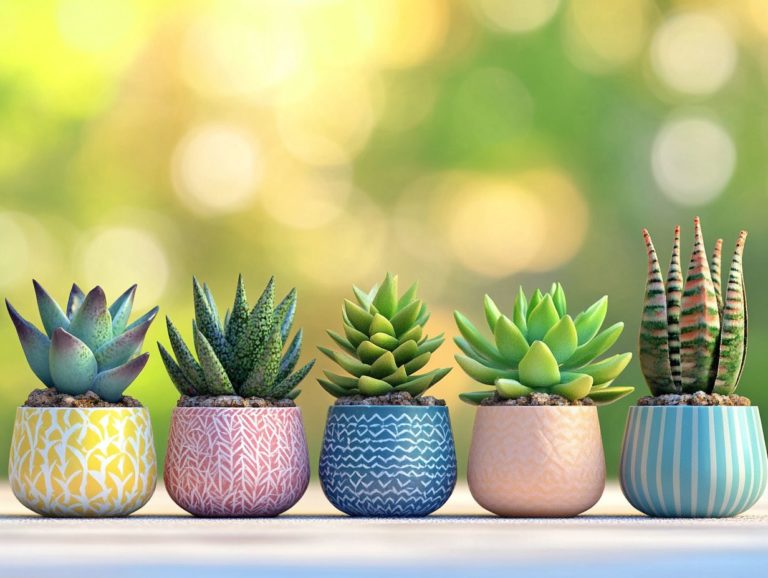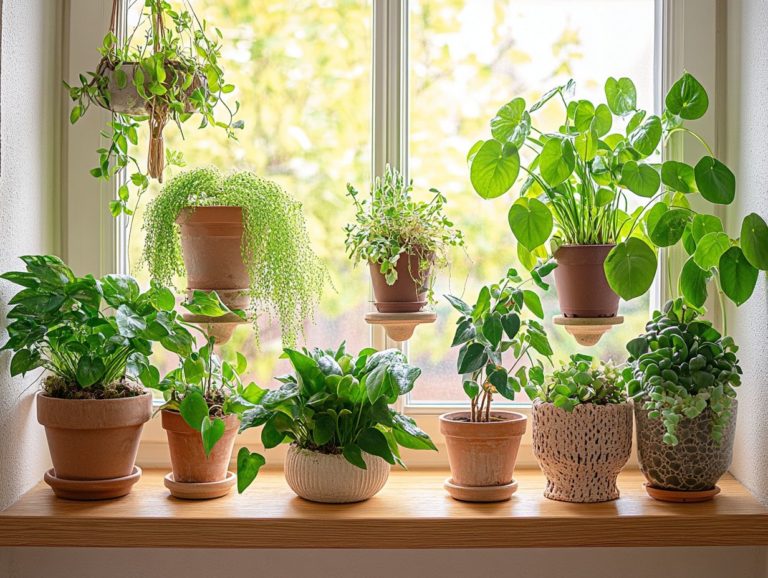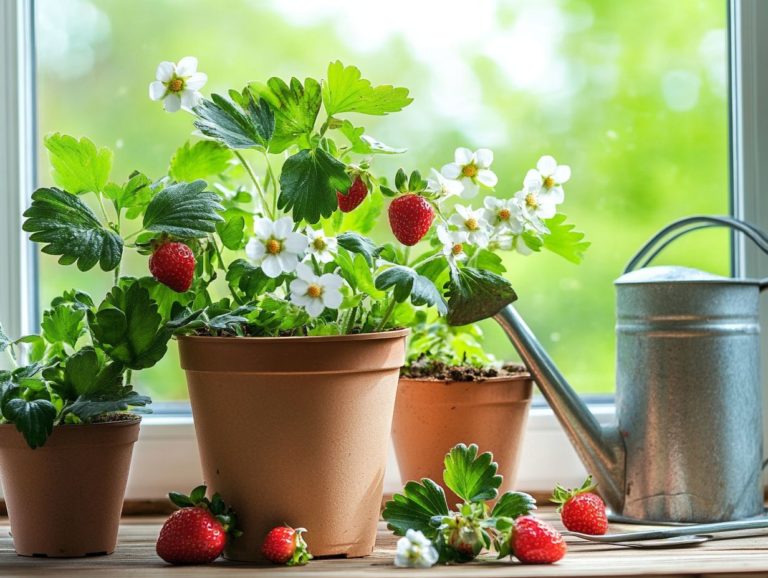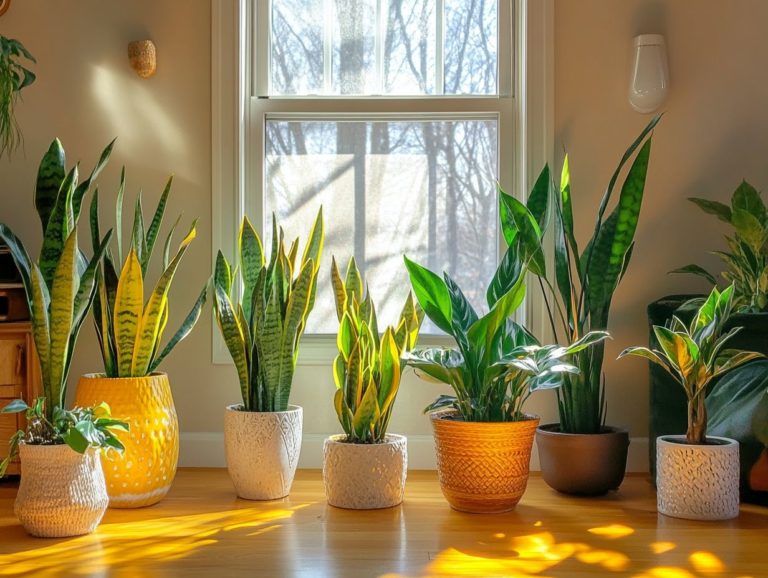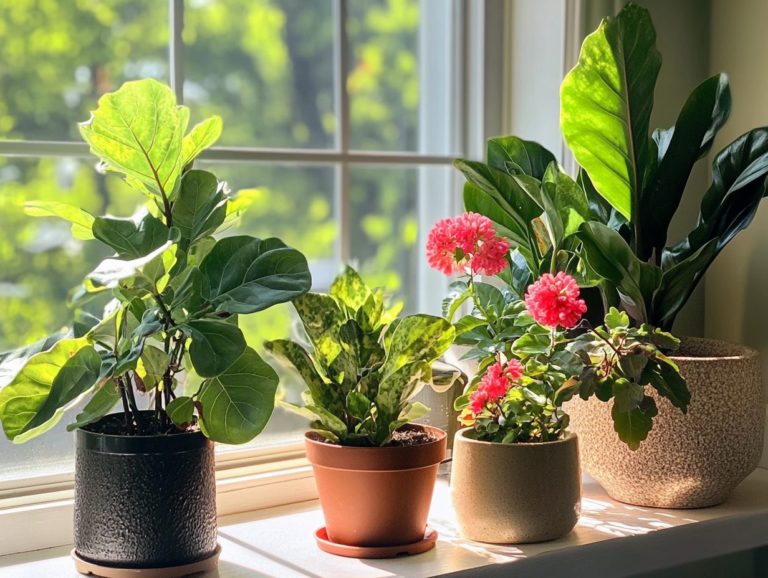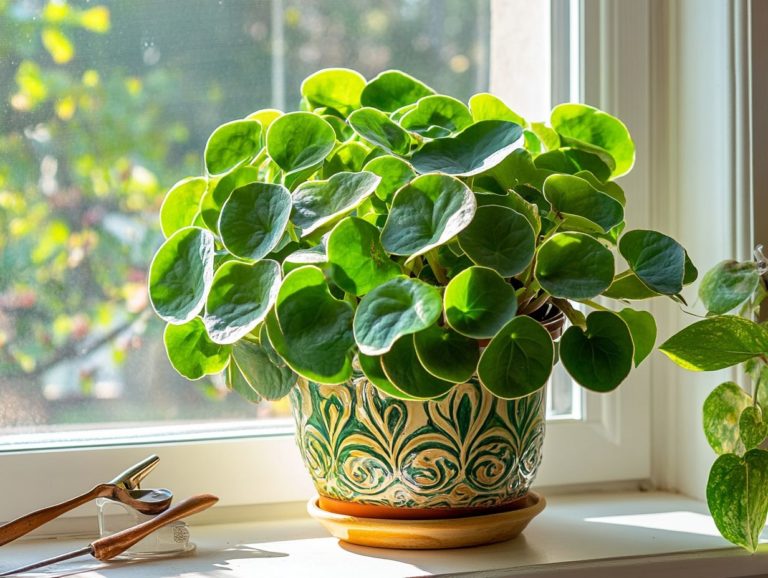The Best Indoor Plants for Kids’ Rooms
Bringing plants into your child’s room isn t just about adding color; it’s a fantastic way to help kids grow and learn responsibility while also enhancing their bedrooms with the benefits of greenery.
The benefits are plentiful, from improving air quality with plants that help clean the air to boosting creativity. Yet, with so many options available, how do you choose the best indoor plants?
This article explores the best indoor plants for children’s rooms, offering tips on plant care, creative displays, and safe selections.
Discover the secrets to creating a vibrant, plant-friendly environment that encourages learning and promotes well-being, especially through engaging gardening activities.
Contents
- Key Takeaways:
- 1. Benefits of Having Plants in Kids’ Rooms
- 2. Factors to Consider When Choosing Indoor Plants for Kids’ Rooms
- 3. Top 10 Indoor Plants for Kids’ Rooms
- 4. How to Care for Indoor Plants in Kids’ Rooms
- 5. Tips for Introducing Plants to Kids
- 6. Plants That Can Be Harmful to Kids
- 7. Creative Ways to Display Plants in Kids’ Rooms
- 8. Educational Activities for Kids with Plants
- 9. How Plants Can Help Improve Kids’ Sleep
- 10. How to Make a Kids’ Room More Plant-Friendly
- 11. Common Problems with Indoor Plants and How to Solve Them
- 12. Plants That Can Help Purify Indoor Air
- 13. How to Incorporate Plants into a Kid-Friendly Design
- 14. DIY Plant Projects for Kids
- Frequently Asked Questions
- What are the benefits of having indoor plants in kids’ rooms?
- What are some low-maintenance indoor plants suitable for kids’ rooms?
- Are there any indoor plants that are safe for pets in kids’ rooms?
- How can I make sure my kids don’t accidentally ingest any plants?
- What are some fun ways to involve kids in caring for indoor plants?
- How can I add indoor plants to the decor of my kids’ rooms?
Key Takeaways:
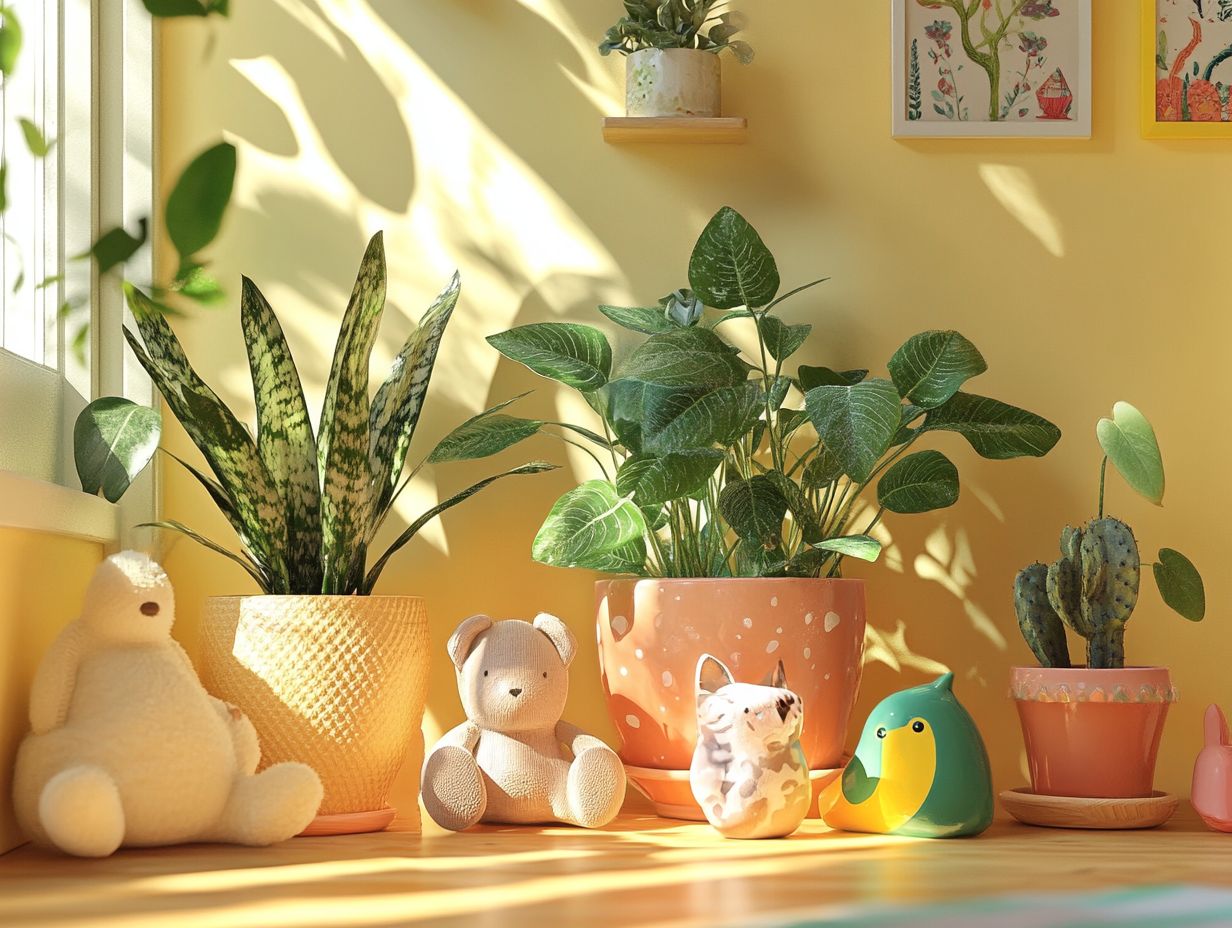
- Incorporating plants in kids’ rooms has many benefits, including improving air quality and reducing stress and anxiety.
- Make sure to prioritize safety when choosing indoor plants for kids’ rooms, considering ease of care and educational value.
- Some great indoor plant options for kids’ rooms include the non-toxic Spider plant, African violet, and resilient Snake plant.
1. Benefits of Having Plants in Kids’ Rooms
Having plants in your kids’ rooms offers numerous benefits. They improve air quality with options like the Spider plant and Snake plant, and create a soothing environment that enhances safety and well-being.
These green companions do more than just clean the air. Plants like the non-toxic Peace Lily and Aloe vera can significantly reduce stress, fostering a calm atmosphere for relaxation and focus.
Caring for plants teaches children responsibility, helping them understand the importance of nurturing living things.
These interactions can spark creativity, inspiring imaginative play and artistry, enriching their learning environment with interesting textures and colors.
2. Factors to Consider When Choosing Indoor Plants for Kids’ Rooms
When selecting indoor plants for your child’s room, consider several factors: the plant s safety, maintenance requirements, watering needs, and light requirements. This ensures that the chosen plants thrive and pose no risk to your little ones.
Safety is crucial, so opt for non-toxic plants to prevent accidental ingestion or skin irritation. Evaluate the natural lighting available in the room; some plants prefer bright conditions, while others thrive in low light.
Understanding the care level is essential too. Some plants require frequent watering and pruning, while others, like the Calathea, are low-maintenance ideal for busy families.
By balancing these considerations, you can nurture a safe and vibrant environment for your children. Consider options like spider plants, African violets, or pothos that meet all these criteria.
3. Top 10 Indoor Plants for Kids’ Rooms
Explore the top 10 indoor plants that are perfect for kids’ rooms, featuring non-toxic options like the Spider plant and African violet. These plants not only enhance decor but also create a safe and nurturing environment for your little ones.
These vibrant plants offer a delightful assortment of textures and colors that can ignite a child’s imagination while providing numerous benefits. For instance, the Spider plant is known for its air-cleaning abilities and low-maintenance care, making it a fantastic choice for busy parents. The African violet adds color, inviting children to connect with nature at home. Meanwhile, the resilient Snake plant thrives in low light and increases oxygen production, creating a refreshing space for play and relaxation. To explore even more options, check out the best indoor plants for unique spaces.
Each of these plants helps cultivate a harmonious space that prioritizes the well-being and safety of children.
Start transforming your child’s room today with these amazing plants!
4. How to Care for Indoor Plants in Kids’ Rooms
Caring for indoor plants in a child’s room means understanding their unique watering needs and light requirements. This ensures that even low-maintenance varieties thrive while instilling a sense of responsibility in your little ones for their green companions, such as the peace lily.
Opting for plants like spider plants, pothos, or peace lilies can be a brilliant choice. These species adapt well to various lighting conditions and demand minimal attention, making them safe plants for children. You can easily set up a simple watering schedule maybe once a week teaching your kids the value of consistency.
Encouraging them to observe their plants regularly helps them spot signs of distress, such as yellowing leaves or wilting. This creates opportunities for problem-solving. This hands-on experience not only sparks their interest in botany but also fosters patience and nurtures an appreciation for the beauty of nature. It enhances their understanding of the plant lifecycle.
5. Tips for Introducing Plants to Kids

Introducing plants to kids can be an exhilarating adventure. With the right strategies, you can transform this experience into an educational gardening opportunity that invites children to engage with nature. They can discover the nuances of plant selection and care, including the fascinating world of flora for kids.
Involving them in the selection process not only sparks their creativity but also instills a sense of ownership over their gardening project. You can teach them about various species, including Aloe vera, illustrating the fundamentals of plant biology like how plants make their food from sunlight using straightforward language and interactive activities that capture their interest.
Creating a regular gardening routine lets kids see the exciting results of their hard work! The joy of nurturing plants fosters a deeper appreciation for the environment. It can instill lifelong values of responsibility and patience in young learners, further connecting them to the beauty of nature.
6. Plants That Can Be Harmful to Kids
While many houseplants are perfectly safe for children, it is crucial for you to be aware of those that can pose risks. Avoid toxic plants now to keep your little ones safe and happy! By steering clear of species known to be toxic or irritating, such as the Philodendron, you can ensure a safer environment when selecting plants for their rooms.
Some common plants that could be problematic include:
- Philodendrons
- Pothos
- Dieffenbachia
- Venus fly trap
- Rubber plants
Ingesting these can lead to symptoms ranging from mild stomach upset to more serious reactions. Rubber plants and snake plants can cause skin irritation if touched. Therefore, conducting thorough research is essential before welcoming any houseplants into your child’s space.
Understanding the potential hazards linked to these plants will enable you to create a safer living area while enjoying the aesthetic and wellness benefits that houseplants can bring, ensuring your children’s safety.
7. Creative Ways to Display Plants in Kids’ Rooms
Creative displays of indoor plants can truly transform your kids’ rooms into vibrant spaces. They showcase delightful textures and lively colors. By integrating plant care into daily routines, you not only enhance the aesthetics of the room but also cultivate a budding love for nature in your children through hands-on learning experiences.
Consider incorporating unique display ideas, such as hanging planters that dangle from the ceiling. This allows your little ones to easily reach their green companions and witness their growth firsthand. Creative shelf arrangements enable you to showcase a variety of plant sizes, including Echeveria, adding dynamic visual interest while presenting educational opportunities about different plant species.
DIY plant stands provide another exciting way for your kids to engage in hands-on projects. They foster a sense of accomplishment as they nurture their botanical friends. These interactive displays not only beautify the space but also instill responsibility and curiosity. They transform gardening into a delightful family activity that emphasizes the importance of flora for kids.
8. Educational Activities for Kids with Plants
Engaging children in educational activities centered around plants can truly elevate their learning experience. It nurtures their curiosity about nature and instills a sense of responsibility through caring for plants. As they observe growth and transformation, it becomes an enriching experience for kids.
By incorporating hands-on experiences like planting seeds, they can witness the miracle of life firsthand. Nurturing their new green companions, like the African violet, teaches them patience and diligence. It also introduces essential biological concepts, such as how plants use sunlight to make food and the plant lifecycle.
Creating a plant journal offers a wonderful opportunity for reflection and documentation of these lessons. This reinforces their understanding of ecology and the benefits of houseplants. This bond with nature inspires kids to take pride in every sprout! Let them experience the magic of growth.
9. How Plants Can Help Improve Kids’ Sleep
Incorporating air-purifying plants, such as the Spider plant or Snake plant, in your kids’ rooms can greatly enhance their sleep quality. The calming presence of greenery creates a serene atmosphere that paves the way for restful nights.
Introducing plants like lavender, snake plants, or peace lilies not only elevates air quality but also contributes to a soothing ambiance. Lavender, for instance, is celebrated for its calming scent, which helps reduce anxiety and fosters relaxation both essential for a good night’s sleep. Just having these plants around can provide a psychological boost, lowering stress levels in children and creating a more inviting environment.
Numerous studies show that surrounding children with nature not only improves their sleep patterns but also cultivates a sense of tranquility, encouraging uninterrupted rest.
10. How to Make a Kids’ Room More Plant-Friendly
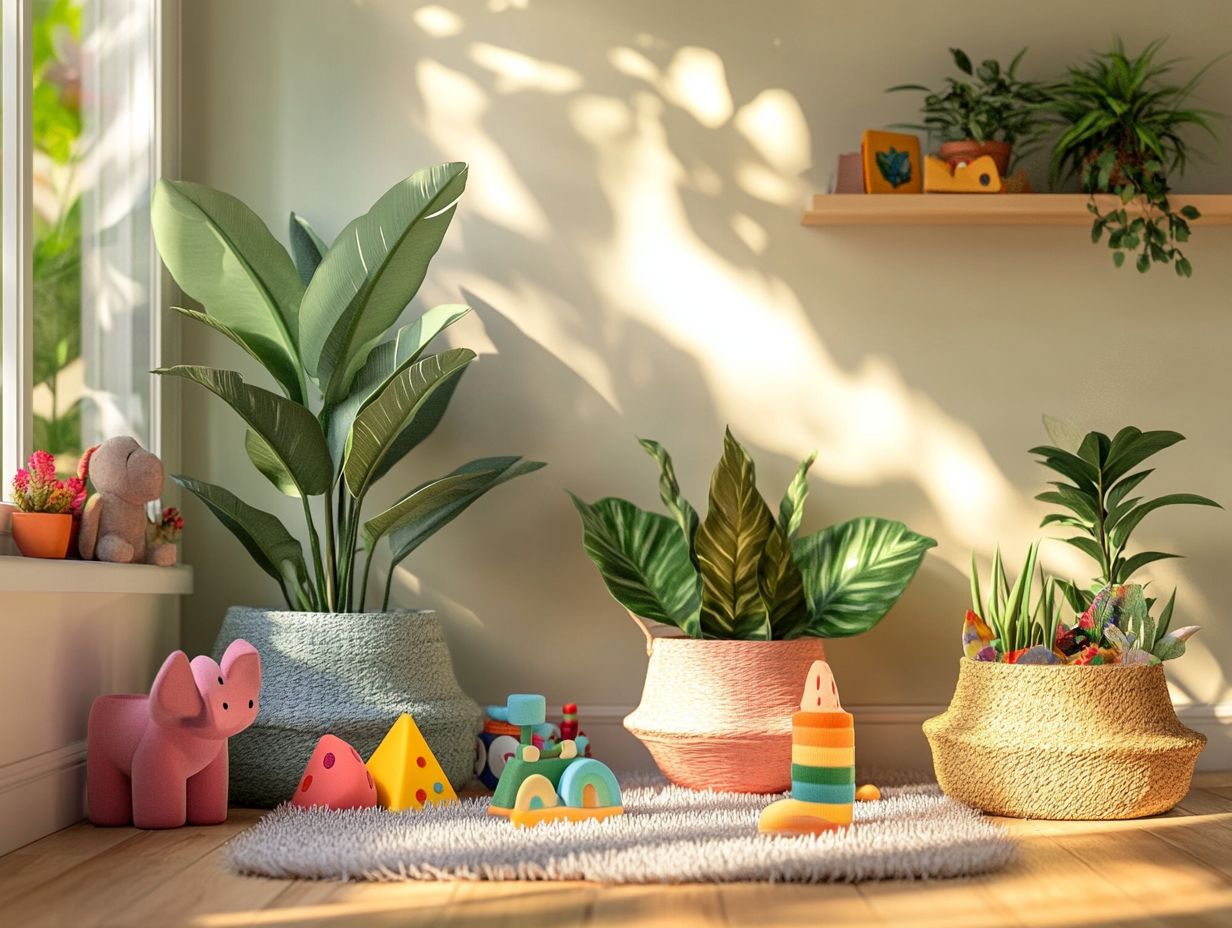
Transforming a kids’ room into a plant-friendly sanctuary requires careful planning. Use thoughtful plant selection and strategic arrangements to create a harmonious environment for both children and their leafy companions.
Start by assessing the size and layout of the room. Think creatively about utilizing shelves or hanging planters to maximize space without making it feel cluttered. When selecting plants, choose non-toxic varieties, like spider plants or pothos; not only are they safe, but they also bring a lively aesthetic that brightens the space. For improved air quality, consider learning more about the best indoor plants to enhance your environment.
Give each plant plenty of sunlight to help them thrive! Positioning them near windows or opting for low-light varieties will keep them flourishing beautifully. Get your kids involved in watering and caring for their plants! They ll love watching them grow.
By prioritizing both the visual charm and safety of the plants, you can transform the room into a nurturing haven that inspires creativity and growth.
11. Common Problems with Indoor Plants and How to Solve Them
Indoor plants can come with their fair share of challenges, but with the right care and knowledge, you can effectively tackle issues like pests, overwatering, and inadequate light conditions to keep your children s plants thriving.
Pay attention to symptoms that signal distress, such as yellowing leaves or stunted growth. If pests make an unwelcome appearance, consider using natural insecticidal soap; it s a gentle yet effective solution that protects both the plant and its environment. Ensuring the plants are positioned in appropriate lighting and using well-draining soil can greatly minimize the risk of overwatering a common pitfall.
By teaching your kids these essential principles, you not only nurture a sense of responsibility but also cultivate a deeper appreciation for nature. This journey allows them to witness the truly rewarding growth of healthy indoor plants firsthand. Did you know? Kids who care for plants often feel happier and more relaxed!
12. Plants That Can Help Purify Indoor Air
Certain houseplants are exceptional at purifying the air. They are perfect choices for your children’s rooms, where clean air is essential for their health and wellness.
Plants like spider plants, peace lilies, and snake plants truly shine with their remarkable ability to filter out harmful toxins from the air. The spider plant, with its lush green leaves, effectively captures pollutants like formaldehyde and xylene, transforming the space into a fresher haven.
Peace lilies not only enhance the room s aesthetics but also absorb carbon monoxide and naturally boost humidity, adding both beauty and practicality.
Then there s the snake plant, affectionately known as mother-in-law s tongue. This resilient plant takes the night shift, performing photosynthesis after dark, making it an excellent choice for improving air quality while your kids sleep.
When combined, these plants create a caring space that actively supports your children’s respiratory health and overall well-being.
13. How to Incorporate Plants into a Kid-Friendly Design
Incorporating plants into a kid-friendly design requires you to strike a balance between aesthetics and functionality. This allows children to engage with indoor greenery while prioritizing their safety and ease of care.
Integrate vibrant plant shelves to create a playful and engaging space! These shelves showcase a delightful array of plants and double as interactive learning tools.
For a whimsical touch, think about using playful decorations, like animal-shaped pots or colorful planters that capture a child s imagination.
Don’t forget the educational aspect; accessible plant care stations equipped with child-safe tools can provide an engaging, hands-on experience for budding botanists.
By blending these design elements, you create a nurturing environment that sparks curiosity and responsibility, fostering a deeper appreciation for nature in young minds.
14. DIY Plant Projects for Kids
Engaging in DIY plant projects offers a wonderful opportunity to create hands-on learning experiences for your kids. It allows them to tap into their creativity while grasping the fundamentals of gardening, all while enjoying cherished moments with their plants.
By diving into activities like crafting vibrant plant terrariums or designing personalized pots, you unlock a realm of imagination and growth. These projects inspire children to express their artistic flair and impart essential lessons about responsibility and the care of living things.
Transforming a simple mini indoor garden into a science lesson lets them observe firsthand how plants grow and flourish, making the entire experience both educational and enjoyable. Each creation becomes a unique reflection of their personality, instilling a sense of pride and ownership in their little green spaces.
Frequently Asked Questions
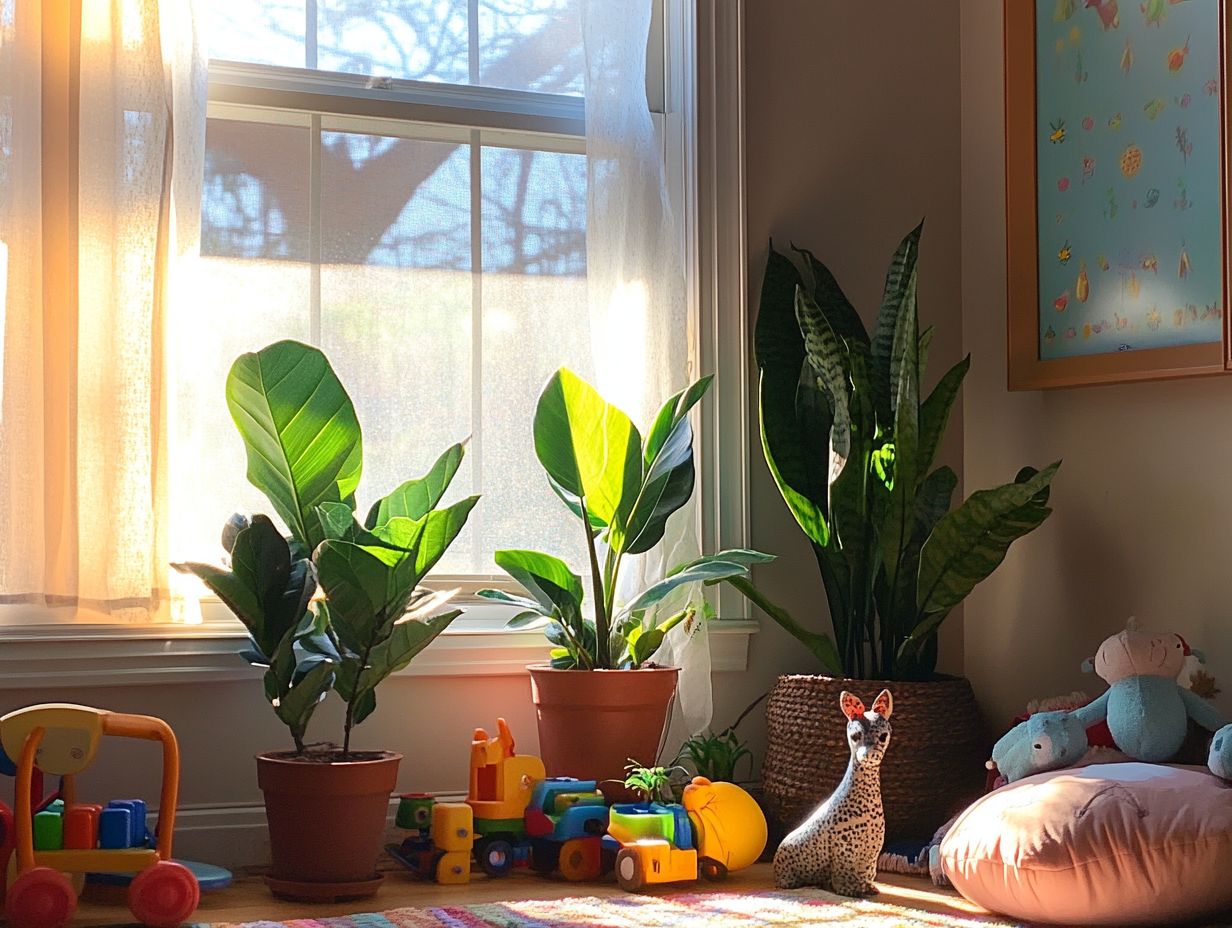
What are the benefits of having indoor plants in kids’ rooms?
Indoor plants not only add aesthetic value to a room, but they also have numerous benefits for children. They can improve air quality, reduce stress and anxiety, and promote a sense of responsibility and nurturing in kids.
What are some low-maintenance indoor plants suitable for kids’ rooms?
Snake plants, spider plants, and peace lilies are great options for low-maintenance indoor plants. They require minimal watering and can thrive in low light conditions, making them perfect for kids’ rooms.
Are there any indoor plants that are safe for pets in kids’ rooms?
Yes, there are several indoor plants that are safe for both kids and pets. Some examples include Boston ferns, African violets, and Christmas cacti. However, it’s always best to research the specific plant and consult with a veterinarian before bringing it into your home.
How can I make sure my kids don’t accidentally ingest any plants?
It’s important to choose non-toxic plants for kids’ rooms and to place them out of reach. You can also teach your kids not to touch or eat any plants without adult supervision. If you have any concerns, consider using hanging planters or placing plants on high shelves.
What are some fun ways to involve kids in caring for indoor plants?
Kids can help with watering and pruning plants. They can also learn about different types of plants and choose which ones to have in their room.
This involvement fosters a love for nature and plants in children.
How can I add indoor plants to the decor of my kids’ rooms?
There are many creative ways to add plants to kids’ rooms! Use colorful pots or create a plant wall or hanging garden.
You can even make DIY terrariums together. Let their imagination run wild and have fun!

